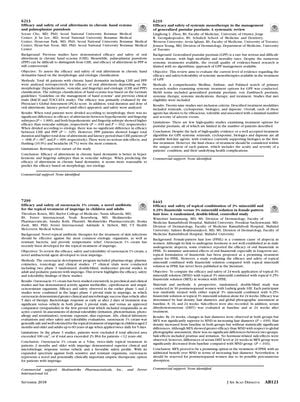Efficacy and Safety of Systemic Monotherapy in the Management of Generalized Pustular Psoriasis: A Systematic Review
August 2018
in “
Journal of The American Academy of Dermatology
”

TLDR Different treatments for skin conditions were found to be effective and generally safe, with biologics recommended as the first choice for generalized pustular psoriasis.
The document presents findings from four separate studies on treatments for various dermatological conditions. The first study (ID 6213) evaluated the efficacy and safety of oral alitretinoin in 46 patients with chronic hand dermatitis, including chronic hand eczema (CHE) and palmoplantar pustulosis (PPP). It found that alitretinoin was more effective in hyperkeratotic and fingertip subtypes than in the vesicular subtype, and that efficacy was better predicted by morphology rather than etiology. PPP patients required longer treatment durations and higher doses than CHE patients, with flushing and headache being the most common side effects.
The second study (ID 7299) reviewed the efficacy and safety of ozenoxacin 1% cream, a novel antibiotic for treating impetigo in children and adults. It included 17 clinical trials and found that ozenoxacin was effective against resistant bacteria and provided a superior clinical and microbiologic response compared to a vehicle, with a favorable safety profile when applied twice daily for 5 days.
The third study (ID 6219) systematically reviewed the efficacy and safety of systemic monotherapies for generalized pustular psoriasis (GPP). Twenty-nine studies were included, showing that retinoids, cyclosporine, biologics, and dapsone were all efficacious and tolerable, with biologics being supported as the first-line treatment. However, due to the lack of high-quality evidence, treatment should be tailored to individual patient contexts.
The fourth study (ID 6443) compared the efficacy and safety of a topical combination of 3% minoxidil and 0.25% finasteride (MFX) versus 3% minoxidil solution (MND) alone in 30 postmenopausal women with female-pattern hair loss (FPHL) over 24 weeks. MFX was found to be significantly superior to MND in increasing hair diameter, with no significant differences in hair density or global photographic assessment. Side effects were minimal, and serum dihydrotestosterone levels significantly decreased in the MFX group. MFX was suggested as a promising treatment option for FPHL in postmenopausal women.





